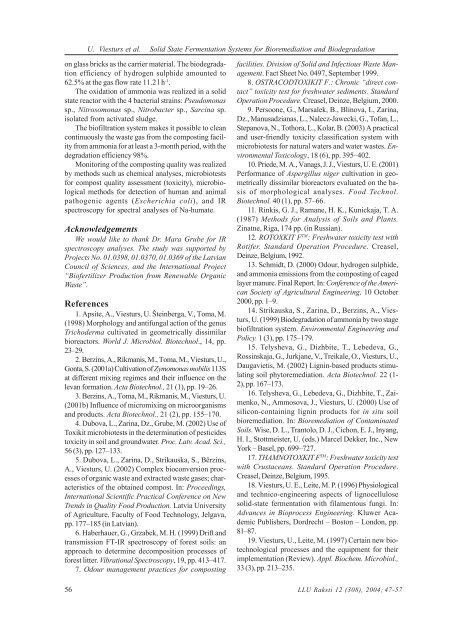saturs - Latvijas LauksaimniecÄ«bas universitÄte
saturs - Latvijas LauksaimniecÄ«bas universitÄte
saturs - Latvijas LauksaimniecÄ«bas universitÄte
- No tags were found...
You also want an ePaper? Increase the reach of your titles
YUMPU automatically turns print PDFs into web optimized ePapers that Google loves.
U. Viesturs et al. Solid State Fermentation Systems for Bioremediation and Biodegradationon glass bricks as the carrier material. The biodegradationefficiency of hydrogen sulphide amounted to62.5% at the gas flow rate 11.2 l h -1 .The oxidation of ammonia was realized in a solidstate reactor with the 4 bacterial strains: Pseudomonassp., Nitrosomonas sp., Nitrobacter sp., Sarcina sp.isolated from activated sludge.The biofiltration system makes it possible to cleancontinuously the waste gas from the composting facilityfrom ammonia for at least a 3-month period, with thedegradation efficiency 98%.Monitoring of the composting quality was realizedby methods such as chemical analyses, microbiotestsfor compost quality assessment (toxicity), microbiologicalmethods for detection of human and animalpathogenic agents (Escherichia coli), and IRspectroscopy for spectral analyses of Na-humate.AcknowledgementsWe would like to thank Dr. Mara Grube for IRspectroscopy analyses. The study was supported byProjects No. 01.0398, 01.0370, 01.0369 of the LatvianCouncil of Sciences, and the International Project“Biofertilizer Production from Renewable OrganicWaste”.References1. Apsite, A., Viesturs, U. Šteinberga, V., Toma, M.(1998) Morphology and antifungal action of the genusTrichoderma cultivated in geometrically dissimilarbioreactors. World J. Microbiol. Biotechnol., 14, pp.23–29.2. Berzins, A., Rikmanis, M., Toma, M., Viesturs, U.,Gonta, S. (2001a) Cultivation of Zymomonas mobilis 113Sat different mixing regimes and their influence on thelevan formation. Acta Biotechnol., 21 (1), pp. 19–26.3. Berzins, A., Toma, M., Rikmanis, M., Viesturs, U.(2001b) Influence of micromixing on microorganismsand products. Acta Biotechnol., 21 (2), pp. 155–170.4. Dubova, L., Zarina, Dz., Grube, M. (2002) Use ofToxikit microbiotests in the determination of pesticidestoxicity in soil and groundwater. Proc. Latv. Acad. Sci.,56 (3), pp. 127–133.5. Dubova, L., Zarina, D., Strikauska, S., Bērzins,A., Viesturs, U. (2002) Complex bioconversion processesof organic waste and extracted waste gases; characteristicsof the obtained compost. In: Proceedings,International Scientific Practical Conference on NewTrends in Quality Food Production. Latvia Universityof Agriculture, Faculty of Food Technology, Jelgava,pp. 177–185 (in Latvian).6. Haberhauer, G., Grzabek, M. H. (1999) Drift andtransmission FT-IR spectroscopy of forest soils: anapproach to determine decomposition processes offorest litter. Vibrational Spectroscopy, 19, pp. 413–417.7. Odour management practices for compostingfacilities. Division of Solid and Infectious Waste Management.Fact Sheet No. 0497, September 1999.8. OSTRACODTOXIKIT F.: Chronic “direct contact”toxicity test for freshwater sediments. StandardOperation Procedure. Creasel, Deinze, Belgium, 2000.9. Persoone, G., Marsalek, B., Blinova, I., Zarina,Dz., Manusadzianas, L., Nalecz-Jawecki, G., Tofan, L.,Stepanova, N., Tothora, L., Kolar, B. (2003) A practicaland user-friendly toxicity classification system withmicrobiotests for natural waters and water wastes. EnvironmentalToxicology, 18 (6), pp. 395–402.10. Priede, M. A., Vanags, J. J., Viesturs, U. E. (2001)Performance of Aspergillus niger cultivation in geometricallydissimilar bioreactors evaluated on the basisof morphological analyses. Food Technol.Biotechnol. 40 (1), pp. 57–66.11. Rinkis, G. J., Ramane, H. K., Kunickaja, T. A.(1987) Methods for Analysis of Soils and Plants.Zinatne, Riga, 174 pp. (in Russian).12. ROTOXKIT F TM : Freshwater toxicity test withRotifer. Standard Operation Procedure. Creasel,Deinze, Belgium, 1992.13. Schmidt, D. (2000) Odour, hydrogen sulphide,and ammonia emissions from the composting of cagedlayer manure. Final Report. In: Conference of the AmericanSociety of Agricultural Engineering, 10 October2000, pp. 1–9.14. Strikauska, S., Zarina, D., Berzins, A., Viesturs,U. (1999) Biodegradation of ammonia by two stagebiofiltration system. Environmental Engineering andPolicy. 1 (3), pp. 175–179.15. Telysheva, G., Dizhbite, T., Lebedeva, G.,Rossinskaja, G., Jurkjane, V., Treikale, O., Viesturs, U.,Daugavietis, M. (2002) Lignin-based products stimulatingsoil phytoremediation. Acta Biotechnol. 22 (1-2), pp. 167–173.16. Telysheva, G., Lebedeva, G., Dizhbite, T., Zaimenko,N., Ammosova, J., Viesturs, U. (2000) Use ofsilicon-containing lignin products for in situ soilbioremediation. In: Bioremediation of ContaminatedSoils. Wise, D. L., Trantolo, D. J., Cichon, E. J., Inyang,H. I., Stottmeister, U. (eds.) Marcel Dekker, Inc., NewYork – Basel, pp. 699–727.17. THAMNOTOXKIT F TM : Freshwater toxicity testwith Crustaceans. Standard Operation Procedure.Creasel, Deinze, Belgium, 1995.18. Viesturs, U. E., Leite, M. P. (1996) Physiologicaland technico-engineering aspects of lignocellulosesolid-state fermentation with filamentous fungi. In:Advances in Bioprocess Engineering. Kluwer AcademicPublishers, Dordrecht – Boston – London, pp.81–87.19. Viesturs, U., Leite, M. (1997) Certain new biotechnologicalprocesses and the equipment for theirimplementation (Review). Appl. Biochem. Microbiol.,33 (3), pp. 213–235.56 LLU Raksti 12 (308), 2004; 47-57 1-18
















